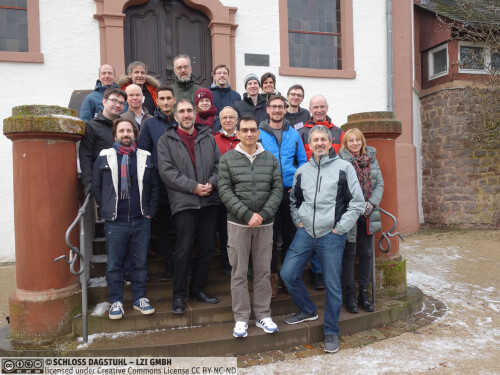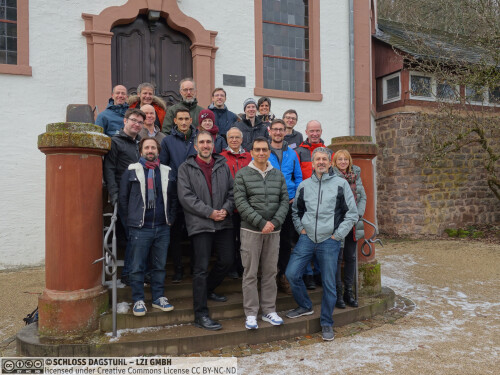Dagstuhl Seminar 22512
Inter-Vehicular Communication – From Edge Support to Vulnerable Road Users II
( Dec 18 – Dec 21, 2022 )
Permalink
Organizers
- Ana Aguiar (Universidade do Porto, PT)
- Onur Altintas (Toyota Motor North America - Mountain View, US)
- Falko Dressler (TU Berlin, DE)
- Gunnar Karlsson (KTH Royal Institute of Technology - Stockholm, SE)
Contact
- Andreas Dolzmann (for scientific matters)
- Simone Schilke (for administrative matters)
Schedule
Looking back at the last decade, one can observe enormous progress in the domain of vehicular networking. In this growing community, many ongoing activities focus on the design of communication protocols to support safety applications, intelligent navigation, and many others. Using the terms Vehicular Ad-hoc Networks (VANETs), Inter-Vehicle Communication (IVC), Car-2-X (C2X), or Vehicle-2-X (V2X), many applications – as interesting as challenging – have been envisioned and (at least) partially realized. Very large projects have been initiated to validate the theoretic work in field tests and protocols are being standardized. With the increasing interest from industry, security and privacy have also become crucial aspects in the stage of protocol design in order to support a smooth and carefully planned roll-out. We are now entering an era that might change the game in road traffic management. Many car makers already supply their recent brands with cellular and WiFi modems, some also adding vehicular WLAN (DSRC, ITS-G5) and C-V2X technologies.
With this latest installment of the "Inter-Vehicular Communication" Dagstuhl Seminar series, we intend to shift the focus from basic networking principles to open challenges in edge computing support and, as a novel aspect, on how to integrate so called vulnerable road users (VRU) into the picture. Edge computing is currently becoming one of the core building blocks of cellular networks, including 5G, and it is necessary to study how to integrate ICT components of moving systems. The trade-offs of computation distribution, system aspects, and the impact on end-to-end latency are still unanswered. Also, vehicular networking and cooperative driving focus almost exclusively on cars but leave out communication and coordination with, for example, pedestrians and bicyclists. And, many of the existing communication solutions for this scenario were designed without having battery constraints in mind. In the meantime, some early research has been initiated on this topic and initial projects report very interesting results on safety features for VRUs. Building upon the great success of the previous Dagstuhl Seminars – as documented, e.g., with results published in widely visible magazine articles [1, 2, 3, 4] – with this follow-up seminar, we aim to again bring together experts from all these fields from both academia and industry.
Seminars in this series focused on general vehicular communication technologies, security and safety impact, cooperative driving concepts and its implications on communication protocol design, and many more. Building upon the online-only seminar in 2021, we now shifted the focus of this seminar from basic networking principles to open challenges in edge computing support and, as a novel aspect, on how to integrate so called vulnerable road users (VRU) into the picture. Edge computing is currently becoming one of the core building blocks of cellular networks, including 5G/6G, and it is necessary to study how to integrate ICT components of moving systems. The trade-offs of computation distribution, system aspects, and the impact on end-to-end latency are still unanswered. Also, vehicular networking and cooperative driving focuses almost exclusively on cars but leaves out communication and coordination with, for ex-ample, pedestrians and bicyclists. For example, many of the existing communication solutions for this scenario were designed without having battery constraints in mind.
The seminar focused intensively on discussions in several working groups. To kick-off these discussions, we invited four keynote talks:
- Vehicles and The Edge: Random thoughts and not so random Perspectives by Jörg Ott (TU Munich, DE)
- Who protects the Unprotected? ITS Services for Vulnerable Road Users by Claudio Casetti (Politecnico di Torino, IT)
- Enabling data spaces: Existing developments and challenges by Gürkan Solmaz (NEC, DE)
- Securing Cooperative Intersection Management by Subjective Trust Networks by Frank Kargl (Ulm University, DE)
We finally organized the following working groups on some of the most challenging issues related to inter-vehicular communication, edge computing, and vulnerable road users:
- Edge computing
- Vulnerable road users
- Vehicle to cloud to vehicle communication
- Sensing and analytics
- Trust
References
- Falko Dressler, Frank Kargl, Jörg Ott, Ozan K. Tonguz and Lars Wischhof, “Research Chal-lenges in Inter-Vehicular Communication – Lessons of the 2010 Dagstuhl Seminar,” IEEE Communications Magazine, vol. 49 (5), pp. 158-164, May 2011.
- Falko Dressler, Hannes Hartenstein, Onur Altintas and Ozan K. Tonguz, “Inter-Vehicle Communication – Quo Vadis,” IEEE Communications Magazine, vol. 52 (6), pp. 170-177, June 2014.
- Onur Altintas, Suman Banerjee, Falko Dressler and Geert Heijenk, “Executive Summary – Inter-Vehicular Communication Towards Cooperative Driving,” Proceedings of Dagstuhl Seminar 18202 on Inter-Vehicular Communication – Towards Cooperative Driving, Schloss Dagstuhl, Germany, May 2018, pp. 31–59.
- Ana Aguiar, Onur Altintas, Falko Dressler and Gunnar Karlsson, “Executive Summary – Inter-Vehicular Communication – From Edge Support to Vulnerable Road Users,” Proceedings of Dagstuhl Seminar 21262 on Inter-Vehicular Communication – From Edge Support to Vulnerable Road Users, vol. 11, Virtual Conference, June 2021, pp. 89–96.
 Falko Dressler, Ana Aguiar, Onur Altintas, and Gunnar Karlsson
Falko Dressler, Ana Aguiar, Onur Altintas, and Gunnar Karlsson
Looking back at the last decade, one can observe enormous progress in the domain of vehicular networking. In this growing community, many ongoing activities focus on the design of communication protocols to support safety applications, intelligent navigation, and many others. Using the terms Vehicular Ad-hoc Networks (VANETs), Inter-Vehicle Communication (IVC), Car-2-X (C2X), or Vehicle-2-X (V2X), many applications – as interesting as challenging – have been envisioned and (at least) partially realized. Very large projects have been initiated to validate the theoretic work in field tests and protocols are being standardized. With the increasing interest from industry, security and privacy have also become crucial aspects in the stage of protocol design in order to support a smooth and carefully planned roll-out. We are now entering an era that might change the game in road traffic management. Many car makers already supply their recent brands with cellular and WiFi modems, some also adding vehicular WLAN (DSRC, ITS-G5) and C-V2X technologies.
With this latest installment of the “Inter-Vehicular Communication”- Dagstuhl Seminar series, we intend to shift the focus from basic networking principles to open challenges in edge computing support and, as a novel aspect, on how to integrate so called vulnerable road users (VRU) into the picture. Edge computing is currently becoming one of the core building blocks of cellular networks, including 5G, and it is necessary to study how to integrate ICT components of moving systems. The trade-offs of computation distribution, system aspects, and the impact on end-to-end latency are still unanswered. Also, vehicular networking and cooperative driving focuses almost exclusively on cars but leaves out communication and coordination with, for example, pedestrians and bicyclists. For example, many of the existing communication solutions for this scenario were designed without having battery constraints in mind. In the meantime, some early research has been initiated on this topic and initial projects report very interesting results on safety features for VRUs. Building upon the great success of the previous Dagstuhl Seminars – as documented, e.g., with results published in widely visible magazine articles [1, 2, 3] – with this follow-up seminar, we aim to again bring together experts from all these fields from both academia and industry.
Following the tradition of Dagstuhl, the seminar will focus on lively interactions and discussions stimulated by two or three keynote talks. We plan organizing these discussions in the form of working groups on main topics of the seminar including virtualized edge computing, pedestrian and bicyclist interaction, and resilience of the underlying communication fabric.
[1] Falko Dressler, Frank Kargl, Jörg Ott, Ozan K. Tonguz and Lars Wischhof, "Research Challenges in Inter-Vehicular Communication - Lessons of the 2010 Dagstuhl Seminar," IEEE Communications Magazine, vol. 49 (5), pp. 158-164, May 2011.
[2] Falko Dressler, Hannes Hartenstein, Onur Altintas and Ozan K. Tonguz, "Inter-Vehicle Communication - Quo Vadis," IEEE Communications Magazine, vol. 52 (6), pp. 170-177, June 2014.
[3] Onur Altintas, Suman Banerjee, Falko Dressler and Geert Heijenk, "Executive Summary - Inter-Vehicular Communication Towards Cooperative Driving," Proceedings of Dagstuhl Seminar 18202 on Inter-Vehicular Communication - Towards Cooperative Driving, Schloss Dagstuhl, Germany, May 2018, pp. 31–59.
 Falko Dressler
Falko Dressler
- Ana Aguiar (Universidade do Porto, PT)
- Onur Altintas (Toyota Motor North America - Mountain View, US) [dblp]
- Khalil Ben Fredj (University of Twente - Enschede, NL)
- Claudio Casetti (Polytechnic University of Torino, IT) [dblp]
- Carla-Fabiana Chiasserini (Polytechnic University of Turin, IT)
- Klaus David (Universität Kassel, DE)
- Falko Dressler (TU Berlin, DE) [dblp]
- Jérôme Härri (EURECOM - Biot, FR) [dblp]
- Geert Heijenk (University of Twente, NL) [dblp]
- Frank Kargl (Universität Ulm, DE) [dblp]
- Gunnar Karlsson (KTH Royal Institute of Technology - Stockholm, SE) [dblp]
- Florian Klingler (Universität Paderborn, DE) [dblp]
- Renato Lo Cigno (University of Brescia, IT) [dblp]
- Marie-Christin Hannah Oczko (Paderborn, DE)
- Jörg Ott (TU München, DE) [dblp]
- Michele Segata (University of Trento, IT) [dblp]
- Gürkan Solmaz (NEC Laboratories Europe - Heidelberg, DE) [dblp]
- Christoph Sommer (TU Dresden, DE) [dblp]
- Lukas Stratman (TU Berlin, DE)
- João P. Vilela (University of Porto, PT & INESC TEC - Porto, PT & CISUC - Coimbra, PT)
- Lars Wolf (TU Braunschweig, DE) [dblp]
Related Seminars
- Dagstuhl Seminar 10402: Inter-Vehicular Communication (2010-10-03 - 2010-10-06) (Details)
- Dagstuhl Seminar 13392: Inter-Vehicular Communication - Quo Vadis (2013-09-22 - 2013-09-25) (Details)
- Dagstuhl Seminar 18202: Inter-Vehicular Communication Towards Cooperative Driving (2018-05-13 - 2018-05-16) (Details)
- Dagstuhl Seminar 21262: Inter-Vehicular Communication - From Edge Support to Vulnerable Road Users (2021-06-28 - 2021-06-28) (Details)
Classification
- Networking and Internet Architecture
Keywords
- Intelligent transportation systems
- Vehicle-to-vehicle communication
- Vehicle-to-infrastructure communication
- Cooperative driving
- Tactile internet
- 5G
- Edge Computing
- Low latency com-munication
- Vulnerable Road Users
- Pedestrians
- Bicyclists



 Creative Commons BY 4.0
Creative Commons BY 4.0
